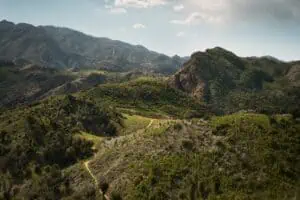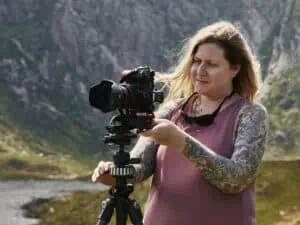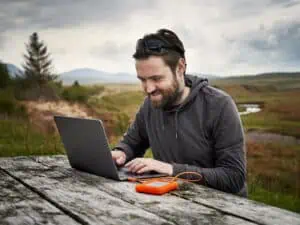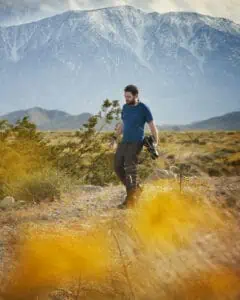Once upon a time, a tripod was seen as an essential piece of equipment for every photographer.If you wanted the best – the sharpest – image quality, then the advice was always to lock your camera onto the biggest tripod you could carry.However, as camera technology has improved, bringing such benefits as improved image quality at high ISO values, lens and body-based stabilisation (VR, IS, OIS or IBIS – manufacturers have a wide range of names for this!) and vibration-free electronic shutter, the need to carry a tripod has been greatly reduced.Indeed, using a mix of in-body stabilisation and electronic shutter, we’ve been able to get reliably sharp results with a hand-held mirrorless camera at shutter-speeds as low as half a second! If you’ve been taking photos seriously for any length of time, you’ll know that a stat like this is incredible. This would have been impossible even just a few years ago with a DSLR camera.
None the less, we think a tripod is still an important piece of equipment and carrying one can be the difference between getting a shot or not. The main job of a tripod is to help us eliminate camera movement. Put simply, if your camera moves during an exposure, it will degrade images quality – that is, sharpness and detail in the final image. The more reliably we can keep our camera still during exposure, the better we can expect the final image quality to be and tripod is still one of the best ways to achieve this. Beyond this, tripods also force you to work in a slower, more considered way – you’ll spend more time setting things up and therefore thinking about your images and this is something that many may feel benefits their creative process.
Let’s take a look at some of our favourite tripods for the trail. We’ve decided to limit this round up to full-sized tripods that you can comfortably work with whilst stood up. We’ve decided to leave out mini or tabletop tripods and other stabilisation devices such as the Joby Gorillapod which often find their way into roundups like this. This isn’t to say these devices don’t have their place – they absolutely do – but in our experience, they just aren’t as versatile as a full-sized tripod and they can quickly become extra weight on a hike.
In brief: The Best Travel Tripods for Every Budget
Our Round Up of the Best Tripods for Travel, Adventure and Backpacking
1. Gitzo Traveler
Gitzo are one of the longest established and best-known tripod brands and their products have a reputation for fantastic quality – and high prices!The Gitzo Traveler Series – available either as legs only or in a kit with a matched centre ball head – is the most obvious starting point here.It’s offered with a number of different options: First of all, there’s the ‘Series’ – either ‘0’ or ‘1’ with the ‘1’ being slightly larger.Each series is also offered with either four or five leg sections – and as you’d expect, the five section version folds up a little smaller than the four section version.As with all Gitzo tripods, the legs use twist locks.The Series 0 with four leg sections is particularly note worthy: with the matching head, it weighs in at under 1.3kg, has a folded height under 37cm, extends to 133cm and yet is still rated for a 10kg load.The price is high, but this is a great range of stats!
As with all Gitzo products, these are made and finished to the highest standard.The carbon leg sections – this tripod is only available in carbon – has a prominent diamond patterned weave and the metal hardware is finished with the grey metallic ‘spatter’ finish that has become Gitzo’s trademark.It’s hard to get excited about the look of a tripod, but you also have to admit that as far as these things go, the Gitzo is beautiful!
2. Manfrotto Befree GT XPRO
Manfrotto is probably the best known tripod manufacturer in the world – and rightly so: the Italian company has a long history of making high quality, resilient and great value products. For many photographers, Manfrotto is the only choice when it comes to tripods! Befree is their family of travel-specific tripods and there are a number of different models within the range.
We are particularly drawn to the Befree GT XPRO range – offered in both a Carbon and Aluminium version.Whilst not as lightweight as the Gitzo (coming in at just under 1.8kg inc. head for the carbon version and 2kg inc. head for the Aluminium version), this tripod extends to over 160cm and is rated for loads of up to 12kg.It’s also comes in at a more attractive price point than the Gitzo.Manfrotto bundles the Befree GT XPRO legs with their 496 ball head – this is a substantial upgrade over the basic ballhead previously bundled with the Befree range and features an ingenious quick release mechanism, that will accept both Manfrotto’s own rectangular release plates and Arca Swiss style plates.
3. Three Legged Thing Brian 2.0
British company Three Legged Thing are relative a newcomer to the market relative to the others here, but they’ve none the less shaken up the market with some innovative and well designed products.They’ve got a massive range of products that can seem daunting to navigate, but their Brian 2.0 ticks all the right boxes for a good travel tripod and it’s offered as a set with Three Legged Thing’s AirHead Neo 2.0 Ballhead, which integrates an Arca compatible clamp.
The key think about this tripod is its versatility.The two section centre column means the tripod can go from just under 20cm at its minimum extension, all the way up to 186cm at its maximum.Beyond this, the tripod legs can removed and replaced with optional extra short legs giving a table top tripod whilst each removable leg can be put into service as monopods, microphone booms or even lighting stands.On top of all of this, the tripod and head weigh in at under 1.7kg, and fold down to 42cm (thanks to five section legs).The legs can be set at different angles and usefully, the company states different maximum load capacities at different leg angles (which makes perfect sense! It would be great if other manufacturers would do this!). With this in mind, the load capacity is stated as between 14kg and 5kg which, in real terms means you should have no issue attaching a camera body with a largeish lens like a 70-200mm f/2.8.The bold colouring may not be to everyone’s taste, but Three Legged Thing also offer an all-black version for those who want something a little more discreet.
4. Manfrotto 055
The Manfrotto 055 has been around in various guises for decades and has a reputation as a true workhorse for both amateur and professional photographers.Today, the 055 is offered in both aluminium and carbon with variants with either three or four leg sections in each material.Many would consider the 055 to be too large for a travel tripod, but we’d disagree.For sure, it’s no ultralight tripods mentioned so far, but it’s still very portable – we have one and have done plenty of long hikes with it lashed to the side of a pack on numerous occasions.The legs can be locked independently at three different angles, so it works well for low angles and on uneven surfaces too.The centre column can also be rotated 90 degrees for over the top or super low angle shooting. Chunky flip-locks secure the leg extensions and we know from years of experience that these just go on and on working in all weather conditions. If we could only choose one tripod, it would probably be the Manfrotto 055!
The real advantage of the 055 series as we see it is that it hits a sweet spot between size and weight without sacrificing capabilities.Most travel specific tripods feel like they make some compromises in terms of their height and stability in order to hit a target weight or size, but not so the 055 – this is absolutely still a sturdy tripod.The tree section version has a working range of between 9cm and 170cm, a folded length of 63cm and a load capacity of up to 20kg that comes in handy in strong winds (that’s all without a head). This tripod might be overkill if you use lightweight mirrorless gear with small lenses, but it’s the perfect choice if you use larger or heavier gear – say, professional DSLRs with grips, very large telephoto lenses or even medium or large format film cameras. Manfrotto also make the slightly smaller 190 series.This may appeal to some as it packs many of the same features of the 055 in a smaller and lighter package – however, we think that it doesn’t quite hit the same sweet spot as the 055.
5. Benbo Trekker Mk. 3
Benbo – not to be confused with the very similar sounding Benro – are definitely the Marmite of the tripod world.Their tripods have been around in various forms since the 80s, but don’t get very much coverage these days, which is a real shame as they offer a truly unique design.There are several models in the Benbo range, but the Trekker Mk. 3 is the most appropriate for this roundup.The industrial design is clunky 80s through and through. This is a fully aluminum alloy tripod and there’s no carbon option offered.At 76cm folded and weighing in at 2kg – and that’s without a head too – it’s definitely a large and heavy tripod, but it’s unique capabilities may well more than make up for this with some users.
Benbo is a contortion of ‘bent bolt’ and describes the unique construction of the tripod: all three legs and the centre column can pivot freely around this bolt and a single lever locks and unlocks all the movement simultaneously.Unlock the bolt and the whole tripod just flops about like a ragdoll… a metal ragdoll with an expensive camera attached to it!In fact, if you’re not careful, the whole tripod can crash to the ground when you unlock the bolt.The first time you use it – the first several times in fact – this is hugely frustrating and you’ll no doubt find yourself fighting against the design.However, in not much time you get used to it and at this point the true genius of the design becomes apparent: Most tripods assume that they will be set up on more or less level ground with the centre column perpendicular.Not so the Benbo.The flexibility allows you to contort the tripod into any number of different spaces.The legs can be braced against walls, trees, whatever and the centre column can easily be placed at any number of angles without impacting stability.The upshot of this is that you can place your camera pretty much anywhere you want.The Benbo’s design redefines what a tripod is and for those who like low angles, ground level or overhead shots, macro or detail work or who regularly shoot on very uneven terrain, the Benbo design is truly liberating and a great option.The Trekker Mk. 3 can extend to a maximum height of 160cm and is rated for a maximum load capacity of 8kg. These figures may not sound that impressive next to the other tripods in this round up, but remember, this is a very different beast and the Trekker’s unique selling point is the flexibility it offers within these limits.
Other photography content you might enjoy:
Your needs in a tripod can vary greatly depending on what equipment you’re using and how you’re planning on using it.The best tripod might actually be a selection of different tripods! We have three very different tripods that we regularly work with – ranging from a massive, full-sized tripod that’s over a meter long when folded and close to 7kg to a super light weight carbon fibre travel tripod that can easily be tucked into the side pocket of a backpack. Each tripod has it’s place and, just like any other gear choices, our selection of which one to bring will depend on what we anticipate shooting.
The Anatomy of a Tripod and Features to Look Out For
A tripod consists of two main parts – the legs (and, if you want to be pedantic, the legs alone constitute the tripod) and the head.Within this basic plan, there are a wide range of different design variants.Most so called ‘travel tripods’ sacrifice height and stability to achieve a smaller, lighter product and some have come up with novel design features to help here.The legs on some travel tripods – like the Gitzo Traveller and Manfrotto Befree – can fold over the head to make the folded tripod more compact.Travel tripods also usually incorporate more telescopic leg sections to allow them to be smaller when collapsed. Certain models such as the Gitzo Traveler offer variants with different numbers of leg sections: The five-section version is a more compact design than the four-section version when folded. On the flip side, it will take longer to set up the five-section version, it doesn’t extend to the same height and it costs a bit more too.
Every tripod in this round up has a telescopic centre column. This is a great way to get some extra height when the tripod is fully extended – that’s especially relevant with travel tripods that don’t extend very high. However, extending the centre column also impacts stability – sometimes by a lot! It’s always better practice to extend the tripod’s legs as much as you can before you extend the centre column.We always try to get the positioning more or less correct with just the legs and then use a little centre column adjustment to fine tune things.
Size, Weight, Stability and Carrying Capacity
The recommendation always used to be that the best tripod was the heaviest one you could carry. This advice saw us both carrying around tripod and head combos that weighed north of 5kg early on in our careers. You can absolutely see the logic in this – you ideally want your camera to be immovable once mounted on the tripod – but we also need to offset this the realities of how much weight you can comfortably carry and also what you actually need the tripod to be able to support.
Camera gear is getting smaller and lighter! Twenty years ago, serious landscape photographers would routinely work with medium and large format film cameras.Ten years ago, DSLR cameras were dominant and today, mirrorless cameras are becoming the camera of choice (though there’s still plenty of people out there – us sometimes included – using older and even antique technology and processes to create unique images). It’s perhaps a bit of an over-simplification, but it’s broadly true to say that each of these camera types has not just lost weight and bulk relative to the previous generation, but also introduced new technology to reduce the factors that lead to camera shake. With this in mind, a good tripod for a medium format film camera could well be complete overkill for a more modern mirrorless camera.
When choosing a tripod, we think it’s important to start by thinkingabout what you need it to be able to do: How much does your heaviest camera and lens actually weigh? Do you realistically need to very tall tripod when hiking? How important is low angle shooting?
The key factors to look for in any tripod are its sized – both folded and extended.But don’t just look at the tripod’s maximum height: also consider its minimum height. Consider its weight and how much it can support. If you’ve assessed your needs from a tripod as we previously suggested, making sense of manufacturer’s spec sheets can suddenly become a whole lot easier!
One other factor to bear in mind is that a tripod’s load bearing capacity should be considered an absolute maximum and will likely assume an ideal setup on level ground. It’s worth remembering this if you often find yourself shooting at extreme angles and in these instances a tripod rated for a heavier load than you need is worth considering.
Material – Aluminum vs Carbon Fibre
For a very long time, aluminium was the only choice when it came to tripods, but since the early 2000s, carbon fibre has emerged as an alternative material. When carbon tripods first appeared, there were some concerns about how durable they’d be in the long term, but the consensus now is that carbon is every bit as durable as aluminium in general use and we certainly have no issue with the durability of our carbon tripods. Many tripods are offered in both carbon and aluminium versions. The trade off here is usually pretty simple: aluminium costs less – sometimes a lot less – but weights more. Carbon is more expensive and lighter. There are some meaningful weight savings to be made with carbon – for example Manfrotto quotes 2.5kg vs 2kg respectively for the otherwise identical aluminium and carbon version of the three section 055, however, this weight saving almost doubles the RRP of the tripod! The bottom line is that if you can afford it, carbon is a worthwhile upgrade, but we think it shouldn’t be the only factor that influences your purchase decision.
Quick Release Plates and L Brackets
The days of screwing your camera directly onto a tripod head are long gone! All but the most basic of tripod heads will also incorporate some form of quick release.This takes two parts: a quick-release plate that attaches to your camera’s tripod socket and some sort of clamp on the tripod head to allow you to quickly attach and detach the camera. There’s a multitude of different options here – Manfrotto alone have offered at least four different proprietary quick release systems over the years!However, the Arca Swiss quick release system has emerged as the closest thing to an industry-wide standard in recent years as it provides a huge amount of versatility in terms of the size of the plates and locking clamp – so one system can be used for all sorts of hardware from the lightest compact camera up to the most massive super telephoto lens. A wide range of manufacturers now offer ‘Arca compatible’ quick release systems at a range of price points.
An L-Bracket takes the idea of a quick release plate one step further: it’s a device that cradles your camera and offers two quick release surfaces. The reason behind this is that you can change your camera between horizontal/landscape and vertical/portrait orientation without having to flip the tripod head into its ‘portrait mode’. This can really help to improve stability and we’d seriously recommend investing in an L bracket – especially if you use heavy lenses. They are available in different sizes for DSLR and mirrorless cameras and also for larger professional bodies used with a vertical grip.
Use Your Head – A Smart Upgrade
Many travel tripods come as a kit with a basic ball and socket head.The kit head is often a great starting point, but it’s also worth bearing in mind that a tripod works as a system with the attached head and the system is only as stable as the weakest element. If your tripod legs are rated to hold a 10kg load, but the attached tripod head is only rated to 2kg, then 2kg is your system’s limit! With this in mind, you’ll quickly realise that a lightweight head can undermine the stability of your entire support system.
If you’re new to the world of camera supports, it’s worth mentioning that tripod heads attach to legs via a standard 3/8 inch screw fixing, so you can easily mix and match heads and legs from different manufacturers. Tripod heads can get very expensive, but there’s also plenty of budget options that can really improve on the stability of the basic kit head as well as adding extra usable features.
Our lightest tripod is a Manfrotto Befree and we’ve upgraded the kit head to an Artcise PB40. This inexpensive upgrade not only boosts the load capacity and stability of the system without adding much overall weight, but also adds a native Arca compatible quick release clamp and a separate pan control above the ball. We regularly produce stitched panoramas which require a levelled camera as a starting point and this second pan control is huge time-saver.
For Stills Photography, There are Three Main Types of Head:
Ball and socket heads have a single multi-directional pivot point.More advanced B&S heads also have a separate pan control below the ball. This type of head is generally preferred by landscape or travel photographers as they are generally the lightest and most compact. They allow the camera to be positioned quickly, but fine-control of the camera position can be tricky (especially with very long focal length lenses where a fractional shift in the lens position can have a big impact on the final composition).None the less, we think the advantages outweigh the problems, and we think a B&S head is the best choice for outdoors work.
Pan and tilt (or ‘3D’ or ‘three way’) heads offer separate controls panning as well as side to side and front to back tilt. They are characterised by having three prominent control levers.If weight and bulk were no question, we’d pick a high quality pan and tilt head over a ball head any day (in fact, we think the Manfrotto 229s might be the best tripod head ever made), as they allow quick and precise positioning of the camera and a long control handle acts as a lever to make positioning heavy camera/lens combos a breeze. However, weight and bulk are most definitely an issue, so we reserve the pan and tilt head – usually paired with a heavy-duty set of legs – for those times when we know we don’t have to hike far.
Geared heads are basically pan and tile heads with extra fine control over the movements provided by gearing. Some landscape photographers – especially those working with ultra-specialised (and ultra-costly!) technical camerasfrom the likes of Phase One and Alpa – swear by these, but we personally find them either too big, heavy, expensive, fragile or slow to work with for travel photography.
Leg Locks and Speed of Use
As with all photo equipment, you need to consider ease and speed of use. One point about tripods that is often overlooked, but which we think is critically important is the leg locking mechanism.There are two main types: twist locks (as featured on the Gitzo traveller – indeed on the entire Gitzo range) are reliant on screw threads whilst flip locks (as featured on the Manfrotto 055) are simply hinged levers.Which type you prefer is a personal choice – in fact, you may not have strong feelings either way, but we’ll be blunt: we much prefer flip locks!
You should also consider how the tripod will fit in with the kind of environments you photograph in: if you regularly work in very cold places, you should look out for oversized controls that are easy to operate with gloves on.
If you regularly need to work quickly, then a tripod with fewer leg sections will absolutely be quicker to set up.
Disclaimer: This article contains Affiliate Links. You won’t pay any more for buying through these links, but we may receive a commission from any purchases made through them. As an Amazon Associate, I earn from qualifying purchases. If you choose to support us by buying through our links, we thank you as it helps us to continue providing the resources we do to help you enjoy the outdoors more!










